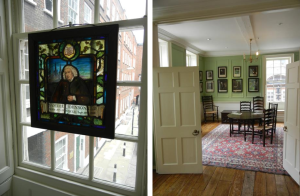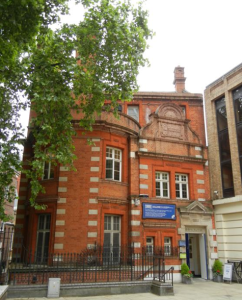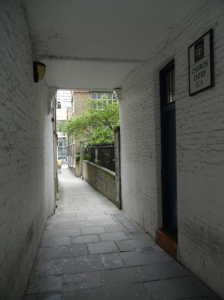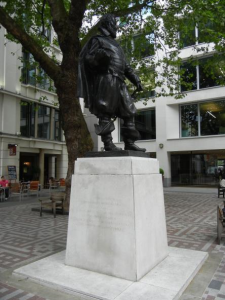Here is the conclusion to my London walk. To read the first part of my walk, click here.
After my lunch I continued along the narrow passageway and came out onto a street called Hatton Garden. There were lots of jewelry stores along this street and apparently the area is famous for dealing in diamonds. I turned left down to Holborn Street and crossed the road. I turned left through a doorway that led through to “Bernard’s Inn,” which is now known as Gresham College. It provides free lectures to the public on a variety of topics. I walked through a passageway that led to some beautiful buildings, including a 15th century hall that used to be one of the Inns of Chancery (colleges for lawyers) and later became a school for the Mercer’s Company, another of the trade guilds. In 1991 it became part of Gresham College. This place had an “untouched” feel to it, with a small courtyard and really nice landscaping. I was impressed with the neatness and cleanliness of the courtyard.
I continued through the passageway and exited onto Fetter Lane. I turned right and continued on down to New Fetter Lane and saw the statue of John Wilkes, the 18th century Lord Mayor of London and a member of parliament (MP). I crossed the lane and passed the library of King’s College, then turned left into West Harding Street and then Pemberton Row. This led to Gough Square and Dr. Johnson’s house. The square is surrounded by 18th century houses and on entering it I felt I had stepped back in time to when Dr. Johnson walked the streets of the city. Dr. Johnson is famous for writing a dictionary of the English language and he compiled it while living at 17 Gough Square. He published the dictionary in 1755. This catalog of English words is an important reflection and record of the English culture of Johnson’s time. The house is open to the public and I went into the house to take a look. My first encounter with Dr. Johnson was when I read Thackeray’s novel Vanity Fair while a student in the 1980s. In the novel, the heroine, Becky Sharpe, throws away the dictionary that has been given to her as a present from her school, but she tosses it towards the other young ladies and teachers as she is leaving the school.” In doing so she rejects the conventions of her time and demonstrating her independent nature.
I must have spent well over an hour looking around Dr. Johnson’s house. My favorite room was the first floor landing and rooms, but the best thing about the house was probably the views it affords over Gough Square and Pemberton Row. This is an amazingly well preserved part of London and appears to be largely unchanged since the eighteenth century. I purchased a copy of the guide to the house, published by Dr Johnson’s House Trustees. According to this guide, “In 1747 [Dr. Johnson] published the Plan for his famous A Dictionary of the English Languageand it was in order to carry out the major work of compiling the dictionary that he rented 17 Gough Square, a house he was to live in between 1748 and 1759. That dictionary was, for over one hundred years, to be the standard work on the English Language.”
I thoroughly enjoyed my visit to Dr. Johnson’s house and after purchasing a postcard with his famous quote “No man but a blockhead ever wrote, except for money,” printed on it I left the house and continued my walk. I walked along another passageway called Johnson’s Court and exited onto Fleet Street, near to St. Paul’s cathedral. I crossed the road and took Pleydell Court, down part of a hill to Lombard Lane and then left onto Temple Lane. At the end of this lane I turned right onto Bouverie Street and left through Magpie Alley. This led to the offices of Freshfields, a well-known law firm. I looked over a railing by the office building and saw, preserved behind a large glass window, the remains of the crypt of the medieval monastery called Whitefriars, from which this this part of London gets its name. The Whitefriars monastery covered quite a large area. From the crypt of the old monastery, I continued along the alley until I eventually came to Ashentree Court. I turned right onto Whitefriars Street and then left onto Primrose Hill. I followed this around past Harrow pub and at the end of the street I walked up some steps to Salisbury Square. This is a nice little “hidden” square with benches and landscaping around a central memorial to Robert Waithman, who was Lord Mayor of London and an MP from the early nineteenth century who advocated parliamentary reform. This little square seemed to be used mostly by office workers wanting a smoke break. After lingering a few moments to look at the memorial to Mr. Waithman, I took St. Bride’s Passage to the St. Bride Foundation Institute and printing library.
I had never heard of this institution until I read about it in my guidebook. A sign outside the main entrance said tours of the printing room could be had for £5. Since I have an interest in anything to do with the publishing industry, I thought I’d like to look at the printing room. I went inside the building to the reception and asked the lady there if I could have a tour of the printing room. After waiting for a few minutes, the guide came down to meet me. After introducing ourselves – it turned out that he had been interviewed by the BBC for a documentary about the history of printing – I followed him up some stairs to the printing room. This was like a small museum and contained numerous old printing presses from the nineteenth century and early twentieth century. He told me the names of them and showed me a cabinet full of lengths of lead that were used to add spacing between lines of text (hence, the word “leading” to define line spacing in documents). I regret to say that I did not write down the names of the printing presses in the room, so I don’t remember them; but it was a very interesting display.
According to the guide, the Foundation makes money from teaching typography design and printing courses, giving tours of its collections, and renting out meeting rooms to companies and other organizations. After finishing the tour, I walked out past the library that contains rare and valuable volumes related to the printing trade and practices. I walked out onto a narrow lane that led to New Bridge Street. I crossed the road and walked over to a Caffe Nero coffee shop at 100 New Bridge Street. These cafes are ubiquitous around London but the coffee is quite good quality. I stopped there to have a cappuccino and take a short rest. According to the barista who served me, these cafés are a UK-based chain that was started by an American living in the country.
After finishing my coffee I left the café and turned right along New Bridge Street and then right again into Pilgrim Street. I jogged up some quite steep steps and turned right into Ludgate Broadway. I found my way through a series of alleyways and walked through a very narrow one called Church Entry, which passes through an area that used to be part of Blackfriars Monastery.
I passed a couple of small gardens, the second of which was the churchyard of St. Ann Blackfriars. It is a small grassed park with gravestones around the perimeter. At the end of the alleyway, I turned left onto Burgon Street. When I reached Creed Lane, I turned left onto Ludgate Square, which I followed to Ludgate Hill. From here I turned right and reached the forecourt of St. Paul’s Cathedral. There were lots of people standing around the steps at the front entrance to the cathedral. There must have been a special event going on there that afternoon. I walked around the cathedral to the left and found myself opposite the St. Paul’s tube station, from where I had started my walk.
There was just one more thing I wanted to see on this walk and that was the nearby statue of John Smith, the merchant adventurer from London. He was actually born in the county of Lincolnshire, in the middle of England, and was one of the principal pathfinders for the English settlement of North America; which led ultimately to the establishment of the United States. John Smith was one of the original founders of the English colony of Jamestown that resulted in the permanent settlement of Virginia. He is famous for being saved by Pocahontas, the daughter of chief Powhatan, after Smith had been captured by the chief’s tribe. After passing St. Paul’s I turned right before reaching the tube station and walked along Cheapside until I got to a Starbuck’s café next to St. Mary-le-Bow church. I turned right after passing Starbucks and a short walk brought me to the statue of Captain John Smith right in the middle of a small square, surrounded by benches. It was quite an imposing statue – martial in its bearing, up on a plinth. Arriving at this point marked the end of my walk.
I then went into Starbucks and sat at a table next to the window overlooking the statue. I’d seen a lot of places that I hadn’t seen before during my walk and it was a lot of fun to find the places mentioned in the guidebook. I can really recommend walking as the best way to see the city and if you take a guidebook with you, you will learn a lot because wherever you turn in London you will see something of historical importance.
Note: My guide for this walk was Andrew Duncan’s Favourite London Walks.This is a very useful book, with descriptions of 50 walks around London. The description of each walk includes a brief description of some of the places along the route and an easy-to-follow map.





No comments yet.